
"We only speak Dutch at school"
“We only speak Dutch at school” - I still hear my colleague saying this while responding to two Turkish-speaking students in a hallway at the University. The event caught my attention and made me think about ways in which linguistic diversity could be considered beneficial rather than a threat. A few months later, I had the opportunity to visit a secondary school for refugee students in the Netherlands. During this visit, I joined a PE class, interviewed a teacher experienced in teaching Dutch as a second language, joined an English class, and conducted an interview with the team leader.
The site visit spanned several hours and gave me a good first impression about the successes and the difficulties faced by those working at this school. One of the key incidents that caught my attention was the school’s language policy: education is provided in Dutch, though students are allowed to talk to each other in their home languages to a certain extent. For example, when the teacher explains some new concepts, students are allowed to help each other out in their own language. Nevertheless, none of the teachers speaks one of the most common languages at the refugee center. The way in which this school deals with linguistic diversity inspired me to further my knowledge on educational language policies. This brought me to the following question: What educational language policy supports newcomers best in learning the Dutch language?
Linguistic diversity in education
Multilingual education is a hot topic in the Netherlands: while students are encouraged to learn new languages at school, the multilingualism brought by newcomers is mainly considered to be an obstacle to success (Sierens & Van Avermaet, 2014). Education for newcomers in the Netherlands has one main goal: teaching them Dutch (Onderwijsinspectie, 2014). What follows is the language immersion principle: using solely Dutch as the language of schooling (Wulftange, 2017). Some schools have even implemented the policy of “only Dutch is allowed at school” (Groothoff, 2016), banning the use of other languages.
This monolingual attitude is clearly in line with the dominant monolingual perspective adopted in the Netherlands (Gielen & Işçi, 2015; Hajer & Spee, 2017). The primary reason for the monolingual approach is integration: the use of home languages would obstruct the language learning process for students. Therefore, it is best to immerse children with a migration background in the Dutch language as soon and as often as possible. Within this perspective, there is no room for the home language of these children at school.
A second argument focuses on the aspect of time: whenever children use their home language, they “steal away” time they could use to practice Dutch, so this ultimately slows down the development of their second language (Sierens & Van Avermaet, 2014; Van den Branden & Verhelst, 2008). Some even argue that multilingual education results in being "zerolingual", meaning not being proficient in any language (Sierens & Van Avermaet, 2014). Further, the use of only one language prevents the exclusion of students and teachers that do not speak other languages (Wulftange, 2017).
Since multilingual education has not been really supported by politics yet, it has not had the chance to prove itself.
The supporters of bilingual or multilingual education claim that paying attention to the home languages of students and actually using their knowledge of other languages has been shown to have a positive influence on their development. They argue that education in the home language in addition to or in combination with education in the language of schooling is beneficial for the children. It provides a more effective basis for learning the language of schooling than total immersion does (Sierens & Van Avermaet, 2014). According to them, learning a new language takes place by building upon knowledge of previously learnt languages. Further, education in the home language supports positive identity construction and is therefore important for the wellbeing and social-emotional development of children. This in turn has a positive effect on their school performance (Sierens & Van Avermaet, 2014; Wulftange, 2017).

Room for new talents
In early 2017, a new guideline for all primary schools that deal with newcomers in their classes was released by the Ministry of Education, Culture and Science and the PO-Raad, the sector of organization for primary education. The advice was entitled “Room for new talents” (Hajer & Spee, 2017), and it emphasized the importance of paying attention to the culture and language of newcomers. The report stressed the importance of the multilingual setting in which children are raised, stating that a fast development of Dutch as a second, additional language alongside the home language are the starting point for education during integration. In addition, the authors claimed that there is a close connection between language and cognitive processes.
A new language is learnt by using the home language. Hence, it is recommended to make use of this already existing knowledge and to rely on a natural learning process instead of abandoning the home language altogether. The report also highlighted the language-independence of educational skills such as written comprehension, mathematics and drawing conclusions. According to the interdependency theory of language acquisition, formulated by educational psychologist Jim Cummins (1979, 2000), these skills are developed best in the most familiar language and are easily transmissible as soon as the child is competent enough in the second language.
Above all, the use of one’s home language is globally protected: Unesco states that every child has the right to develop him or herself through his or her own language. At the same time, the child must be given the opportunity to follow education in the language of the country of residence (Hajer & Spee, 2017).
Multilingual education: a critical analysis
Several countries have experimented with multilingual education far longer than the Netherlands have. Examples include Canada and the United States. Several theories have thus been developed, such as the interdependency theory of language acquisition introduced above(Cummins, 1979, 2000) as well as the concepts "additive" and "substractive" bilingualism (Lambert, 1974). Additive bilingualism refers to learning a second language without losing one's home language, and is mostly achieved through the acknowledgment and appreciation of already existing language competence. Subtractive bilingualism is the opposite: the home language is threatened and eventually replaced by the acquisition of the second language, mostly because it is not valued by society. The latter concept applies to many newcomers in monolingual countries like the Netherlands (Sierens & Van Avermaet, 2014).
There is a difference between positively encouraging the use of Dutch and the complete banning of home languages.
Despite the fact that many American studies have been published on the subject, US research has not succeeded yet in providing us with a clear direction. A lot of these studies feature methodological shortcomings, causing problems in drawing conclusions. Further, it seems difficult to tease apart all the variables that influence newcomers' school performance. The implication of an educational model is just one of them. It seems that the choice for either a monolingual or a multilingual approach should depend on the context and target group. At the same time, European studies have not succeeded in delivering conclusive results either. There are too few studies on the matter, and they are riddled with similar methodological shortcomings. In practice, since multilingual education has not been really supported by politics yet, it has not had the chance to prove itself (Sierens & Van Avermaet, 2014).
Dealing with linguistic diversity in education
As a consequence of globalization, linguistic diversity is on the rise. There are several ways to deal with it in education, from banning home languages to organizing multilingual education. Sierens and Van Avermaet (2014) address three strategies that can serve as guidelines for dealing with linguistic diversity.
Strategy 1: a constructive language policy
The first step is to introduce a constructive and open language policy, in which all the languages of students and their parents are included. The idea behind this policy is separating the language immersion principle from a monolingual school regime. As described earlier, some schools with a Dutch language immersion program implement a "Dutch only" policy, creating room for negatively judging all behavior at school that takes place in another language. However, scholars on language acquisition have their doubts when it comes to the principle of "the more exposure, the better", since non-native children learn everyday Dutch quite easily (Van den Branden & Verhelst, 2008). According to a study by Jaspers (2005), difficulties are mostly experienced with the school or academic language. Academic Dutch, referring to the oral, written, auditory, and visual language proficiency required to learn effectively in schools and academic programs is not practiced outside the classroom, since students use informal language to communicate on the playground. This implies that banning home languages outside the classroom would do no good (Sierens & Van Avermaet, 2014).

Another argument that is often used for a "Dutch only" policy in schools is that teachers fear that they would otherwise lose control over the classroom. However, there is a difference between positively encouraging the use of Dutch and the complete banning of home languages. Experience has shown that schools with a linguistically diverse population do not even need to encourage the use of Dutch, since this language is automatically considered the lingua franca. Prohibitive rules do not seem to improve Dutch proficiency of immigrant children either. Therefore, one might opt for a compromise: allowing the use of home languages on the playground but limiting it in the classroom (Sierens & Van Avermaet, 2014).
Strategy 2: language awareness raising
Rampton (1996) emphasizes the importance of interaction between students and teachers in the moulding of attitudes and opinions about language, non-native speakers and multilingualism. This can be reached by implementing a language awareness approach in the classroom, for example by focusing on the home languages of the students. If room is given to these languages in class, children develop a positive attitude towards other languages. Besides, newcomers feel more comfortable since they are allowed to express themselves in their home language. The increased self-esteem of these students has a positive effect on their motivation and school performance (Sierens & Van Avermaet, 2014).
Parents could be addressed similarly: by acknowledging their role, their self-confidence increases in their communication with the school. Parents can also be encouraged to help children with their homework in their own language (Sierens & Van Avermaet, 2014).

Strategy 3: functional multilingual learning
Functional multilingual learning entails everything between language awareness raising and multilingual education. It refers to deliberately making use of the linguistic repertoires of children in school, by using the home language as a stepping stone for learning the second language. Students are encouraged to help each other in class in any language, though in the end they will need to interact with the teacher in Dutch. Although functional multilingual learning is a quite new approach, several studies have shown promising results in terms of school performance (for example: Jaffe, 2003; Moodley, 2007; Moschkovich, 2002; Olivares & Lemberger, 2002; Olmedo, 2003; Peterson & Heywood, 2007; Martin-Jones & Saxena, 2001; Verhelst & Verheyden, 2003).
Advantages of this approach include the fact that the curriculum does not have to be changed, whereas this is necessary for multilingual education. Also, teachers do not need to master these languages themselves and children feel acknowledged and safe (Sierens & Van Avermaet, 2014).
The potential of multilingual classrooms
Research has shown us that multilingual education has not had a chance to prove its effectiveness yet. There are several arguments for allowing home languages into the classroom, though teachers and policy makers appear to have reasons to avoid this approach. Nevertheless, fear and misbeliefs should not misguide us, making us believe that the "Dutch only" policy would be best for children with a migration background. The strategies described above could be adopted as guidelines, leaving it for schools to decide which one would fit best in their context.
The tentative conclusion to draw here is that previous studies concerning multilingual approaches in the classroom seem promising, and should be at least given a chance. Schools must start adopting language policies other than "Dutch only" schooling. The schooling system could thus start experiencing the benefits of linguistic diversity instead of refusing to acknowledging its presence. This would open up opportunities for teachers, newcomers, parents and researchers alike for understanding what is best for children growing up multilingual.
References
Cummins, J. (1979). Linguistic interdependence and the educational development of bilingual children. Review of Educational Research 49, 222–251.
Cummins, J. (2000). Language, Power and Pedagogy: Bilingual Children in the Crossfire. Clevedon: Multilingual Matters.
Gielen, S. & Işçi, A. (2015). Meertaligheid: een troef! Kalmthout: Abimo uitgeverij.
Groothoff, F. (2016). Meer Meertaligheid. Open brief in Onderwijsblad (13).
Hajer, M. & Spee, I. (red.). (2017). Ruimte voor nieuwe talenten. Keuzes rond nieuwkomers op de basisschool. Utrecht: PO Raad.
Jaffe, A. (2003). Talk around text: Literacy practices, cultural identity and authority in a Corsican bilingual classroom. International Journal of Bilingual Education and Bilingualism 6, 202–220.
Jaspers, J. (2005). Linguistic sabotage in a context of monolingualism and standardization. Language and Communication 25, 279–297.
Lambert, W.E. (1974) Culture and language as factors in learning and education. In F.E. Aboud and R.E. Meade (eds) Bilingualism: Psychological, Social and Educational Implications (pp. 91– 127). Bellingham: Western Washington State College.
Martin-Jones, M. and Saxena, M. (2001). Turn-taking and the positioning of bilingual participants in classroom discourse: Insights from primary schools in Britain. In M. Heller & M. Martin-Jones (eds) Voices of Authority and Linguistic Difference (pp. 117–138). London: Ablex.
Moodley, V. (2007). Codeswitching in the multilingual English first language classroom. International Journal of Bilingual Education and Bilingualism 10, 707–722.
Moschkovich, J. (2002). A situated and sociocultural perspective on bilingual mathematics learners. Mathematical Thinking and Learning 4, 189–212.
Mueller Gathercole, V. C., Thomas, E. M., Jones, L., Viñas Guasch, N., Young, N. & Hughes, E. K. (2010). Cognitive effects of bilingualism: digging deeper for the contributions of language dominance, linguistic knowledge, socio-economic status and cognitive abilities. International Journal of Bilingual Education and Bilingualism 13(5), 617-664.
Olivares, R.A. and Lemberger, N. (2002). Identifying and applying the communicative and the constructivist approaches to facilitate transfer of knowledge in the bilingual classroom. International Journal of Bilingual Education and Bilingualism 5, 72–83.
Olmedo, I.M. (2003). Language mediation among emergent bilingual children. Linguistics and Education 14, 143–162.
Onderwijsinspectie. (2004). Het Onderwijs Eerste Opvang Anderstaligen. Retrieved from http://www.lowan.nl/wpcontent/uploads/2014/09/Onderzoeksverslag_onderwij... 2004.pdf
Peterson, S.S. and Heywood, D. (2007). Contributions of families’ linguistic, social, and cultural capital to minority language children’s literacy: Parents’, teachers’, and principals’ perspectives. The Canadian Modern Language Review 63, 517–538.
Rampton, B. (1996.) Crossing: Language and Ethnicity among Adolescents. London: Longman.
Sierens, S., & Van Avermaet, P. (2014). Language diversity in education: Evolving from multilingual education to functional multilingual learning. In D. Little, C. Leung & P. Van Avermaet (Eds) Managing diversity in education: Languages, policies, pedagogies (pp. 204-222). Bristol: Multilingual Matters.
Verhelst, M. & Verheyden, L. (2003) Eindrapport Pilootproject Circus Kiekeboe. Leuven: K.U. Leuven, Centrum voor Taal & Migratie.
Van den Branden, K. & Verhelst, M. (2008) Naar een volwaardig talenbeleid. Omgaan met meertaligheid in het Vlaams onderwijs. TORB (Tijdschrift voor Onderwijsrecht en Onderwijsbeleid) 2007–2008, 315–332.
Wulftange, L. (2017). Op school spreken wij alle talen! Een case study naar de integratie van thuistalen in het basisonderwijs aan nieuwkomers (Master’s thesis, Utrecht University). Retrieved from https://dspace.library.uu.nl/bitstream/handle/1874/354302/Scriptie%20Leo... e%20definitief.pdf?sequence=1